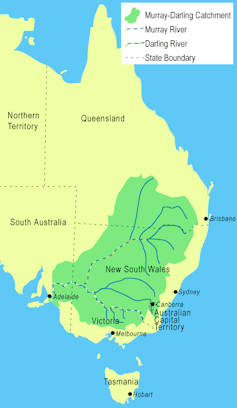Source: The Conversation (Au and NZ) – By Milton Speer, Visiting Fellow, School of Mathematical and Physical Sciences, University of Technology Sydney
Water flows in mainland Australia’s most important river system, the Murray-Darling Basin, have been declining for the past 50 years. The trend has largely been blamed on water extraction, but our new research shows another factor is also at play.
We investigated why the Darling River, in the northern part of the basin, has experienced devastating periods of low flow, or no flow, since the 1990s. We found it was due to a decrease in rainfall in late autumn, caused by climate change.
The research reveals how climate change is already affecting river flows in the basin, even before water is extracted for farm irrigation and other human uses.
Less rain will fall in the Darling River catchment as climate change worsens. This fact must be central to decisions about how much water can be taken from this vital natural system.
A quick history of the Darling

Martyman/Wikimedia, CC BY
The Indigenous name for the Darling River is the Baaka. For at least 30,000 years the river has been an Indigenous water resource. On the river near Wilcannia, remnants of fish traps and weirs built by Indigenous people can still be found today.
The Darling River was a major transport route from the late 19th to the early 20th century.
In recent decades, the agriculture industry has extracted substantial quantities of water from the Darling’s upstream tributaries, to irrigate crops and replenish farm dams. Water has also been extracted from Menindee Lakes, downstream in the Darling, to benefit the environment and supply the regional city of Broken Hill.
A river in trouble
Natural weather variability means water levels in the Darling River have always been irregular, even before climate change began to be felt.
In recent years, however, water flows have become even more irregular. This has caused myriad environmental problems.
At Menindee Lakes, for example, fish have died en masse – incidents experts say is ultimately due to a lack of water in the river system.
Periods of heavy rain in recent years have dramatically improved water flows.
But in between those episodes, water levels and quality have declined, due to factors such as droughts, expanded water extraction, salinity and pollution from farms.
Compounding the droughts, smaller flows that once replenished the system have now greatly reduced. Our research sought to determine why.
What we found
We examined rainfall and water flows in the Darling River from 1972 until July 2024. This includes from the 1990s – a period when global warming accelerated.
We found a striking lack of short rainfall periods in April and May in the Darling River from the 1990s. The reduced rainfall led to long periods of very low, or no flow, in the river.
Since the 1990s under climate change, shifts in atmospheric circulation have generated fewer rain-producing systems. This has led to less rain in inland southeast Australia in autumn.
The river system particularly needs rainfall in the late autumn months, to replenish rivers after summer.
The periods of little rain were often followed by extreme floods. This is a problem because the rain fell on dry soils and soaked in, rather than running into the river. This reduced the amount of water available for the environment and human uses.
In addition to the fall in autumn rainfall, we found the number of extreme annual rainfall totals for all seasons has also fallen since the 1990s.
We also examined monthly river heights at Bourke, Wilcannia and Menindee. We found periods of both high and low water levels before the mid-1990s. But the low water levels at all three locations from 2000 onwards were the lowest in the period.
Ensuring water for all
Australia is the driest inhabited continent on Earth. Ensuring steady water supplies for human use has always been challenging.
Falls in Darling River water levels in recent decades have largely been attributed to water extraction for farm dams, irrigation and town use.
But as our research shows, the lack of rainfall in the river catchment – as a result of climate change – is also significant. The problem will worsen as climate change accelerates.
This creates a huge policy challenge. As others have noted, the Murray-Darling Basin Plan does not properly address climate change when determining how much water can be taken by towns and farmers.
Both the environment and people will benefit from ensuring the rivers of the basin maintain healthy flows into the future. As our research indicates, this will require decision-makers to consider and adapt to climate change.
![]()
The authors do not work for, consult, own shares in or receive funding from any company or organisation that would benefit from this article, and have disclosed no relevant affiliations beyond their academic appointment.
– ref. New research reveals why the mighty Darling River is drying up – and it’s not just because we’re taking too much water – https://theconversation.com/new-research-reveals-why-the-mighty-darling-river-is-drying-up-and-its-not-just-because-were-taking-too-much-water-239923








